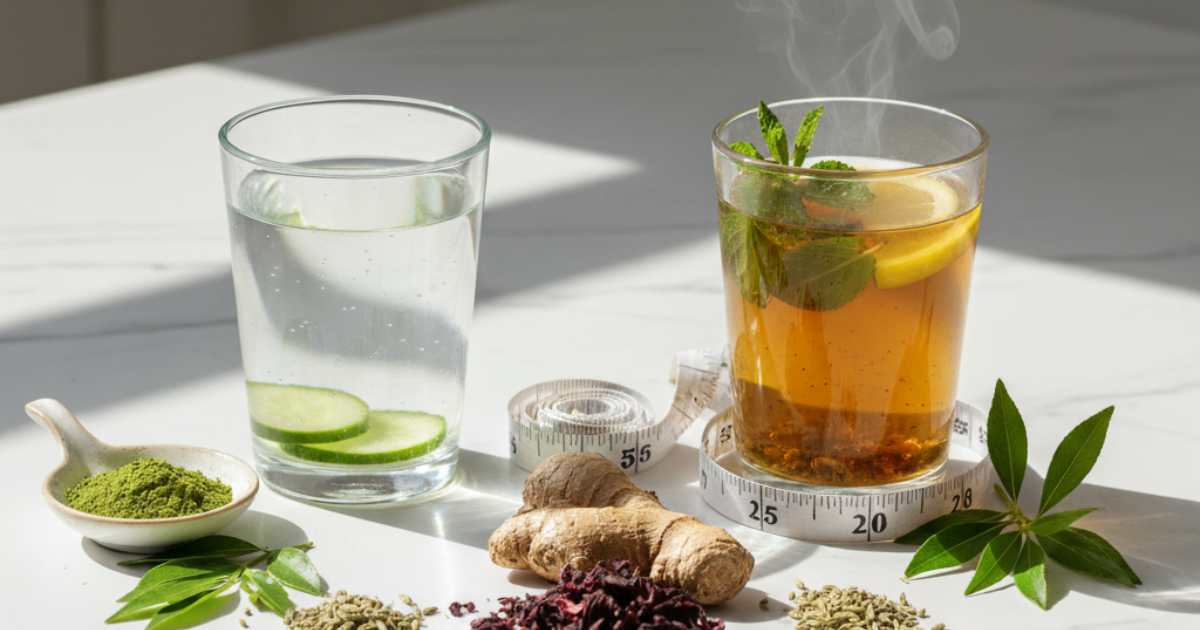The Best Tea for Weight Loss: 12 Metabolism-Boosting Blends Ranked by Science

The Truth About Tea and Weight Loss
In a market flooded with miracle weight-loss promises and quick-fix solutions, it's refreshing to discover that one of the most effective metabolism-supporting tools has been sitting in teacups for thousands of years. Yet not all teas are created equal when it comes to supporting healthy weight management, and understanding the science behind how different tea compounds affect metabolism can help you make informed choices aligned with your wellness goals.
At Terazi Organics, we believe in balance—our name literally means "balance" in Turkish. Weight management isn't about extreme restrictions or unsustainable habits; it's about finding equilibrium between nourishment, movement, and supportive practices that work with your body's natural processes rather than against them.
This comprehensive guide examines twelve scientifically-backed teas that support metabolism and healthy weight management. We'll explore the research, rank them based on efficacy, and help you understand how to incorporate these powerful botanical allies into a balanced approach to wellness. Most importantly, we'll separate genuine science from marketing hype, giving you the knowledge to make choices that truly support your long-term health.
Before we dive in, an essential clarification: no tea replaces the fundamentals of healthy weight management—balanced nutrition, regular movement, adequate sleep, and stress management. Instead, these teas work as supportive allies that can enhance your body's natural metabolic processes when integrated into an overall healthy lifestyle.
The Science of Tea and Metabolism: How It Actually Works
A. Understanding Metabolic Rate
Your metabolism encompasses all the chemical processes that convert food into energy. Your basal metabolic rate (BMR)—the calories burned at rest—accounts for 60-75% of total daily energy expenditure. Several factors influence this rate: age, muscle mass, genetics, hormonal balance, and dietary thermogenesis (the energy required to digest food).
Certain compounds in tea can modestly influence metabolic rate through multiple mechanisms:
Thermogenesis Enhancement: Some tea compounds increase heat production in your body, requiring additional calorie expenditure. Research published in the American Journal of Clinical Nutrition found that green tea extract increased energy expenditure by 4% over 24 hours—a modest but meaningful contribution when sustained over time.
Fat Oxidation Support: Specific catechins and caffeine can enhance your body's ability to break down stored fat for energy, particularly during physical activity. A study in the Journal of Nutrition showed that participants consuming catechin-rich tea before exercise experienced 17% greater fat oxidation compared to placebo groups.
Insulin Sensitivity Improvement: Several tea compounds help your cells respond more effectively to insulin, supporting balanced blood sugar levels and reducing the tendency to store excess calories as fat.
B. Key Compounds That Support Weight Management
Catechins: These powerful polyphenols, particularly epigallocatechin gallate (EGCG), inhibit an enzyme that breaks down norepinephrine—a neurotransmitter that signals fat cells to break down fat. By maintaining higher norepinephrine levels, catechins extend the duration of fat-burning signals.
Caffeine: Beyond its well-known stimulant effects, caffeine increases metabolic rate by 3-11% and specifically enhances fat burning by 10-29%. When combined with catechins, these effects are amplified through synergistic action.
Polyphenols: These diverse compounds support gut microbiome health, and emerging research links beneficial bacteria profiles with improved metabolic function and reduced obesity risk.
Theaflavins and Thearubigins: Found primarily in black tea, these compounds may reduce fat absorption in the intestines while supporting healthy cholesterol metabolism.
C. The Realistic Timeline
It's crucial to maintain realistic expectations. The research shows that tea's metabolic effects, while genuine, are modest—typically increasing calorie expenditure by 75-100 calories daily. However, sustained over months and years, this small daily advantage compounds significantly. Combined with other healthy habits, tea becomes a valuable component of sustainable weight management rather than a standalone solution.
The Top 12 Metabolism-Boosting Teas: Ranked by Scientific Evidence
Green Tea (Camellia sinensis)
Scientific Rating: 10/10
Green tea claims the top position based on overwhelming research evidence. With over 150 published studies examining its effects on metabolism and weight management, green tea stands as the most thoroughly validated botanical for these purposes.
How It Works: Green tea contains high concentrations of EGCG (up to 200mg per cup), working synergistically with caffeine (25-40mg per cup) to enhance thermogenesis and fat oxidation. A meta-analysis of 11 studies published in Obesity Reviews found that green tea catechins significantly decreased body weight and helped maintain weight loss.
Research Highlights:
- Participants consuming green tea extract lost an average of 1.31 kg more than control groups over 12 weeks
- Green tea particularly enhances abdominal fat loss—the metabolically harmful visceral fat
- Effects are most pronounced when combined with exercise
Practical Application: Consume 2-3 cups daily, preferably 30 minutes before exercise for maximum fat-oxidation benefits.
Balance Consideration: Green tea's gentle caffeine content provides energy without the crash, supporting sustainable daily consumption.
Oolong Tea
Scientific Rating: 9/10
Oolong tea occupies the middle ground between green and black tea in terms of oxidation, and this unique position gives it a distinctive metabolic profile combining benefits of both.
How It Works: Oolong contains both catechins and theaflavins, creating dual-action support for metabolism. Research in the Chinese Journal of Integrative Medicine found that oolong tea increased energy expenditure by 10% over two hours—higher than both green and black tea.
Research Highlights:
- Study participants consuming oolong tea for six weeks experienced 6.4% reduction in body fat
- Oolong appears particularly effective at mobilizing fat from adipose tissue
- Shows promise for preventing obesity-related metabolic issues
Practical Application: Steep oolong at 190-200°F for 3-4 minutes. The tea can be re-steeped multiple times, with each infusion offering different flavor notes and beneficial compounds.
Balance Consideration: Oolong's moderate caffeine (30-50mg per cup) provides sustained energy suitable for afternoon consumption without disrupting evening sleep.
White Tea
Scientific Rating: 8.5/10
Often overlooked in weight management discussions, white tea deserves recognition for its unique combination of high catechin content and minimal processing, which preserves delicate compounds.
How It Works: Research published in Nutrition and Metabolism found that white tea extract simultaneously stimulated lipolysis (fat breakdown) and inhibited adipogenesis (new fat cell formation)—a rare dual action.
Research Highlights:
- White tea contains higher concentrations of certain catechins than green tea due to minimal processing
- Test-tube studies show white tea prevents new fat cells from forming
- Powerful antioxidant profile supports overall metabolic health
Practical Application: White tea requires cooler water (160-185°F) and longer steeping (4-5 minutes) to extract its delicate compounds.
Balance Consideration: With the lowest caffeine content of true teas (15-30mg per cup), white tea offers metabolic support suitable even for evening consumption.
Black Tea
Scientific Rating: 8/10
While green tea receives more attention for weight management, black tea offers unique benefits through its distinctive polyphenol profile created during oxidation.
How It Works: Black tea's theaflavins reduce dietary fat absorption by inhibiting pancreatic lipase—the enzyme that breaks down dietary fats. Additionally, black tea polyphenols support beneficial gut bacteria that influence metabolism.
Research Highlights:
- UCLA research found that black tea promotes weight loss by changing gut bacteria composition
- Study participants consuming black tea showed increased Pseudobutyrivibrio bacteria associated with lean body mass
- Black tea consumption correlated with lower body weight independent of caffeine content
Practical Application: Three cups daily appears optimal based on research.
Balance Consideration: Black tea's moderate caffeine (40-70mg per cup) provides sustainable energy that enhances physical activity—a crucial component of weight management.
Yerba Mate
Scientific Rating: 8/10
This South American botanical has gained recognition for its unique combination of caffeine, theobromine, and chlorogenic acids that work together to support metabolism.
How It Works: Yerba mate's methylxanthines (caffeine and theobromine) increase thermogenesis while its saponins slow gastric emptying, promoting satiety. Research in the Journal of Human Nutrition and Dietetics found yerba mate reduced perceived hunger and increased satiety.
Research Highlights:
- Participants consuming yerba mate before exercise showed 24% increase in fat oxidation
- Yerba mate appears to preferentially target abdominal fat
- Contains more antioxidants than green tea according to some measures
Practical Application: Consume 1-2 cups in the morning or before exercise.
Balance Consideration: Higher caffeine content (85mg per cup) makes yerba mate ideal for morning or pre-workout consumption but less suitable for afternoon use.
Pu-erh Tea
Scientific Rating: 7.5/10
This fermented tea from China's Yunnan province offers unique benefits through its post-fermentation process, creating distinctive compounds not found in other teas.
How It Works: Pu-erh's fermentation creates lovastatin-like compounds that help regulate cholesterol metabolism. Research in Phytotherapy Research demonstrated that pu-erh tea consumption led to significant reductions in body weight and BMI.
Research Highlights:
- Animal studies show pu-erh prevents weight gain even with high-fat diet
- Human trials found 1kg average weight loss over 3 months
- Particularly effective at reducing visceral fat and triglycerides
Practical Application: Steep pu-erh with boiling water for 3-5 minutes. The earthy, smooth flavor profile makes it enjoyable without sweeteners.
Balance Consideration: Pu-erh's unique microbial profile supports gut health—increasingly recognized as crucial for metabolic balance.
Hibiscus Tea
Scientific Rating: 7/10
This vibrant herbal infusion offers caffeine-free metabolic support through its unique anthocyanins and organic acids.
How It Works: Hibiscus inhibits the production of amylase—an enzyme that breaks down complex carbohydrates. This slows carbohydrate absorption, reducing post-meal blood sugar spikes. Research in Food & Function found hibiscus extract reduced obesity and fatty liver in animal studies.
Research Highlights:
- 12-week human trial showed participants consuming hibiscus tea experienced reduced body weight, BMI, and waist-to-hip ratio
- Hibiscus appears to target adipose tissue specifically
- May help reduce body fat percentage independent of weight loss
Practical Application: Steep 1-2 teaspoons of dried hibiscus in boiling water for 5-7 minutes. The tart, cranberry-like flavor pairs well with stevia.
Balance Consideration: Caffeine-free nature allows for consumption any time, including evening, without sleep disruption.
Rooibos Tea
Scientific Rating: 6.5/10
South African rooibos offers unique benefits through its aspalathin content—a flavonoid not found in other teas.
How It Works: Aspalathin has been shown to reduce stress hormones that trigger fat storage, particularly visceral fat. Research in Phytomedicine demonstrated that rooibos extract prevented adipocyte differentiation and reduced fat accumulation.
Research Highlights:
- Animal studies show rooibos reduces leptin levels, potentially improving leptin sensitivity
- May help balance blood sugar levels, reducing cravings
- Supports stress management—crucial since cortisol promotes abdominal fat storage
Practical Application: Naturally sweet and caffeine-free, rooibos makes an excellent evening beverage.
Balance Consideration: The stress-reducing properties address an often-overlooked aspect of weight management—the cortisol-belly fat connection.
Ginger Tea
Scientific Rating: 6.5/10
While technically a herbal infusion rather than true tea, ginger's thermogenic properties and digestive benefits warrant inclusion.
How It Works: Gingerols and shogaols in ginger enhance thermogenesis and reduce feelings of hunger. A study in Metabolism found that ginger consumption enhanced thermogenesis and reduced feelings of hunger.
Research Highlights:
- Ginger increases calorie expenditure by improving thermogenesis
- Enhances feelings of satiety, reducing overall calorie intake
- Improves digestion and reduces bloating—supporting the feeling of lightness
Practical Application: Fresh ginger steeped for 10 minutes provides maximum benefits.
Balance Consideration: Ginger's digestive benefits address the gut health foundation essential for metabolic balance.
Dandelion Tea
Scientific Rating: 6/10
This humble plant offers surprising metabolic support through its diuretic properties and effects on fat metabolism.
How It Works: Dandelion contains chlorogenic acid, which helps reduce blood glucose levels. Research in the Journal of Nutrition Research and Practice found dandelion extract reduced body weight and fat accumulation in animal studies.
Research Highlights:
- May inhibit pancreatic lipase, reducing fat absorption similar to black tea
- Supports liver function—crucial for metabolic hormone processing
- Natural diuretic effect reduces water retention
Practical Application: Steep dandelion root (for deeper metabolic support) or leaves (for gentler diuretic effect) for 10 minutes.
Balance Consideration: Dandelion's liver-supporting properties address detoxification—increasingly recognized as important for metabolic health.
Peppermint Tea
Scientific Rating: 5.5/10
While peppermint's direct metabolic effects are modest, its powerful effects on appetite, digestion, and stress make it a valuable supporting player.
How It Works: Peppermint's aroma has been shown to reduce appetite and food cravings. The menthol also relaxes digestive muscles, reducing bloating that can make you feel heavier.
Research Highlights:
- Study participants who inhaled peppermint oil before meals consumed fewer calories
- Peppermint tea consumption associated with reduced stress-related eating
- Improves digestive comfort, supporting consistency in healthy eating patterns
Practical Application: Sip peppermint tea between meals or when cravings strike.
Balance Consideration: Peppermint addresses the psychological aspects of eating—crucial for sustainable weight management.
Chamomile Tea
Scientific Rating: 5/10
Chamomile ranks last for direct metabolic effects but deserves inclusion for its powerful stress and sleep support—both crucial for weight management.
How It Works: Chamomile's primary contribution to weight management comes through improving sleep quality and reducing cortisol. Poor sleep disrupts hunger hormones (leptin and ghrelin), while elevated cortisol promotes abdominal fat storage.
Research Highlights:
- Improved sleep quality correlates with better weight management outcomes
- Stress reduction prevents emotional eating triggers
- May have modest effects on blood sugar control
Practical Application: Consume chamomile 30-60 minutes before bed to support restorative sleep.
Balance Consideration: By addressing sleep and stress—foundational elements of metabolic health—chamomile supports sustainable weight management even without direct metabolic effects.
Creating Your Personalized Tea Strategy for Weight Management
A. The Rotation Approach
Rather than relying on a single tea, create a strategic rotation:
Morning (6-10am): Green tea, black tea, or yerba mate for thermogenic boost and sustained energy Mid-Morning (10am-12pm): Oolong or white tea for continued metabolic support without excessive caffeine Afternoon (12-4pm): Peppermint or ginger tea to curb post-lunch cravings and support digestion Evening (4-8pm): Hibiscus or rooibos for caffeine-free metabolic support Before Bed (8-10pm): Chamomile for stress and sleep optimization
This rotation provides around-the-clock metabolic support while respecting your body's natural circadian rhythms.
B. Maximizing Benefits Through Proper Preparation
Temperature Matters: Higher temperatures extract more catechins but can create bitterness. Find your balance—typically 175-185°F for green/white teas, 200-212°F for black/herbal teas.
Timing Matters: Consuming tea 30 minutes before meals may enhance satiety and reduce calorie intake. Pre-exercise consumption (30-60 minutes before) maximizes fat oxidation benefits.
Avoid Sabotage: Added sugars, artificial sweeteners, and excess milk can negate tea's benefits. If you need sweetness, small amounts of stevia or raw honey are better choices.
C. The 90-Day Tea Transformation Plan
Weeks 1-2: Establish the habit. Focus on replacing high-calorie beverages with tea—each soda or sugary coffee replaced with tea saves 100-300 calories.
Weeks 3-6: Implement strategic timing. Begin consuming tea before meals and workouts for enhanced effects.
Weeks 7-12: Fine-tune your rotation based on how different teas affect your energy, appetite, and digestion.
Research shows metabolic adaptations from tea consumption become more pronounced over time, making consistency more important than perfection.
Beyond the Cup: Integrating Tea into a Balanced Lifestyle
A. The Foundation Remains Essential
Tea enhances—not replaces—fundamental healthy habits:
Nutrition: Focus on whole foods, adequate protein, and fiber-rich vegetables Movement: Combine tea consumption with regular physical activity for synergistic effects Sleep: Prioritize 7-9 hours of quality sleep (where chamomile tea becomes particularly valuable) Stress Management: Use tea rituals as mindful breaks, amplifying stress-reduction benefits
B. Creating Tea Rituals That Support Your Goals
Transform tea consumption from passive habit to active wellness practice:
The Morning Intention: As you steep your morning green or black tea, set intentions for nourishing choices throughout the day.
The Afternoon Reset: When cravings strike, prepare peppermint or ginger tea with full attention, giving your brain time to distinguish true hunger from habitual snacking.
The Evening Wind-Down: Use chamomile or rooibos preparation as a signal that eating hours have ended, creating a natural intermittent fasting window.
These rituals create psychological associations that support sustainable behavior change—often more impactful than the teas' direct metabolic effects.
Realistic Expectations and Sustainable Results
A. The Math of Modest Advantages
If tea increases your metabolic rate by 75-100 calories daily (well within research findings), that's 27,000-36,500 calories annually—equivalent to 8-10 pounds. When combined with tea's appetite-moderating effects and ritual benefits, the total impact becomes meaningful.
However, this requires consistency. Occasional tea consumption provides enjoyment but limited metabolic benefit. Daily consumption over months and years creates sustainable results.
B. Individual Variation
Genetics influence how effectively you metabolize tea compounds. Some people experience pronounced effects from green tea catechins, while others respond better to black tea's theaflavins. This is why the rotation approach proves valuable—it covers multiple metabolic pathways.
Similarly, caffeine sensitivity varies widely. If you're caffeine-sensitive, focus on white tea, hibiscus, and rooibos for metabolic support without overstimulation.
Your Invitation to Balanced Transformation
The journey toward your optimal weight isn't about finding a single magic solution—it's about accumulating small, sustainable advantages that compound over time. The twelve teas explored in this guide offer scientifically-validated metabolic support when integrated into an overall healthy lifestyle.
Begin where you are. Perhaps you start with one morning cup of green tea, gradually expanding to a full rotation that provides metabolic support throughout your day. Pay attention to how different teas affect your energy, appetite, and digestion, personalizing your approach based on your body's unique responses.
Remember that the ritual itself holds power. Each time you pause to prepare tea, you're investing in your wellbeing, creating a moment of intention in a busy day. This mindfulness often proves as valuable as the teas' biochemical effects.




